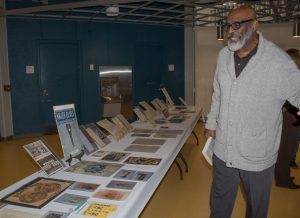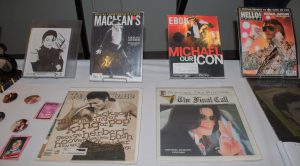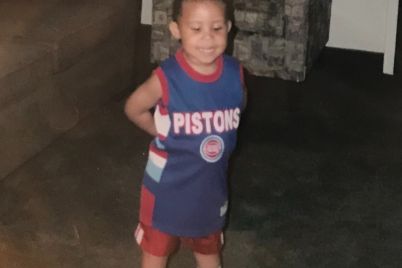
Professor Griff (left) and Khalid El-Hakim (right) are the
founders of the Black History 101 mobile museum.
By Chanel Stitt
Staff Writer
About 200 artifacts covered the long tables dating from times of slavery to current hip hop culture. People were circulating in and out of the room to see these artifacts for six hours of the day.
The Black History 101 Mobile Museum was set up at WCC along with a lecture full of historical information.
“People teach what they’re comfortable with,” said Khalid El-Hakim, founder of the mobile museum.

Thornton Perkins, WCC history professor, looks at artifacts from times of segregation.
El-Hakim went on to explain that many school systems focus on the same public figures while teaching black history; slavery figures that are taught are Harriet Tubman and Fredrick Douglass. Civil rights leaders that are normally included in lectures are Rosa Parks, Martin Luther King and Malcolm X.
El-Hakim asked if anyone attending the lecture could image what it would have been like if the South had won the Civil War.
“One time I went to Gettysburg and they had this place called Little Round Top,” said Thornton Perkins, a history professor at WCC. “They had busloads of kids coming to reenact one charge called the Pickett’s Charge. I was thinking to myself, if Pickett’s Charge had went the other way, our history would’ve been different. Slavery probably would have gone on until the 1930s.”
A listener in the audience asked if he could hold the slave chains after El-Hakim had explained them. These chains hooked onto the ankle and the other end at the wrist with very little distance in between them. As he held the chains at the same length, some members of the audience went into shock. It showed that slaves had to bend over for an entire day’s work.
Going down the tables, there were artifacts portraying black people in negative ways. This includes children’s books, cigarettes and locations on maps that include derogatory slurs. There are many artifacts in the museum that show blacks as more of a gorilla.
Professor Griff, one of the founders of the rap group Public Enemy, works along side of El-Hakim in delivering this museum across the country. He brought up the point that there are many distractions in February and there is not necessarily a black history month celebration.

Micheal Jackson, the King of Pop, had a full section dedicated to his legacy in the mobile museum.
“Black history gets pushed to the background,” said Professor Griff. “The first week was the super bowl, the second week was the Grammy’s, this week is the All Star weekend, and next weekend is the Oscars.”
Having an education on black history and telling stories was emphasized many times during the lecture. The lecture explained the efforts that black people have to put in to achieve what they want to reach.
“I heard this every morning in my home, my mom drilling it in me,” said Professor Griff. “You have to work twice as hard, three times as hard to accomplish what you want to accomplish.”
The mobile museum has around 7,000 artifacts total and has been all over the country to give the lecture. It was a 26 year process to get the artifacts together and it ends with the Jackson 5 era.


